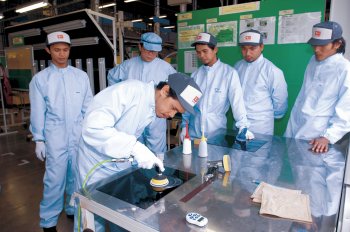Daihatsu’s development overseas
As an expert in mini vehicles, there are things that only Daihatsu can do
Daihatsu Motor Co., Ltd. (Daihatsu)’s image is closely associated with mini vehicles, yet the company is perhaps less commonly thought of as a major player in overseas markets.
At present, the company is expanding its overseas business primarily in Indonesia and Malaysia. Daihatsu uses the technologies and expertise—for fuel efficiency and affordable pricing, for example—it has cultivated through its development of mini vehicles in Japan to develop, produce, and sell compact cars overseas.
Just as in Japan Daihatsu’s mini vehicles are widely used both at home and at work due to their economic performance and ease-of-driving, so overseas Daihatsu’s cars have become indispensable partners in the everyday lives of local customers.
Daihatsu intends to further refine its technologies for making small-size cars, and so contribute to expanding sales of the Toyota Group’s compact cars across the globe.
Japanese Monodukuri
In order to minimize costs and operate its plants in an efficient manner, Daihatsu has developed the Simple, Slim, and Compact (SSC) concept to creating mini vehicles at its Japanese plants. Where appropriate, the company incorporates the same SSC concept in its production sites in Indonesia and Malaysia.
Daihatsu also invites employees from its overseas business sites to its Japanese plants, where they learn about Japanese approaches to manufacturing and about Japanese culture; these employees then return to their own countries, where they assume leadership roles. In this way, Daihatsu contributes to the training of local human resources.
Thanks to such initiatives, Daihatsu’s overseas plants are now capable of producing cars of an equal quality to those produced in Japan.
 Overseas employees take part in technical training
Overseas employees take part in technical training
Aiming to be the best in every country
Daihatsu operates overseas bases in both Indonesia and Malaysia. Despite being neighboring countries in Southeast Asia, Indonesia and Malaysia possess distinct road environments, household compositions, and car design preferences.
“I want to be able to load my car with lots of shopping at the weekend”
“I want to drive in comfort on expressways”
“I want to take my entire family back to my hometown”
Daihatsu’s overseas expansion can be characterized in the following way: cars suited to local needs are built in local plants by local people.
Indonesia
Established in 1992, P.T. Astra Daihatsu Motor (ADM) operates an integrated business that ranges from production to sales. In 2003, ADM launched the Xenia—a car it had jointly developed with Toyota Motor Corporation (Toyota), and which was sold by Toyota as the Avanza—and so accelerated the process of motorization in Indonesia.
In recent years, ADM and Toyota have launched the Ayla (sold by Toyota as the Agia) and Sigra (sold by Toyota as the Calya), both of which met the government’s Low Cost Green Car (LCGC) regulations. At present, ADM produces 15 different models*, and is the No.1 auto manufacturer in Indonesia.
*including consigned/OEM cars for Toyota
-

XENIA
-

AYLA
-

SIGRA
Malaysia
Perodua Manufacturing Sdn.Bhd. (PMSB), which was jointly established by Daihatsu and the Malaysian government, and commenced operations in 1994. Perodua was Malaysia’s second national car manufacturer, and PMSB was Daihatsu’s first full-scale overseas production business.
In order to cater to increasing international competition, Perodua has implemented structural reforms, and commenced operations at a new body, engine, and transmission plant. In this way, the company is seeking to improve its competitiveness as quickly as possible.
Following its structural reforms, Perodua has launched the Axia, the Bezza, and the Aruz; these models are all highly regarded by local customers, and have helped the company retain its position as market leader for a 16th year in succession.
-

AXIA
-

BEZZA
-

ARUZ